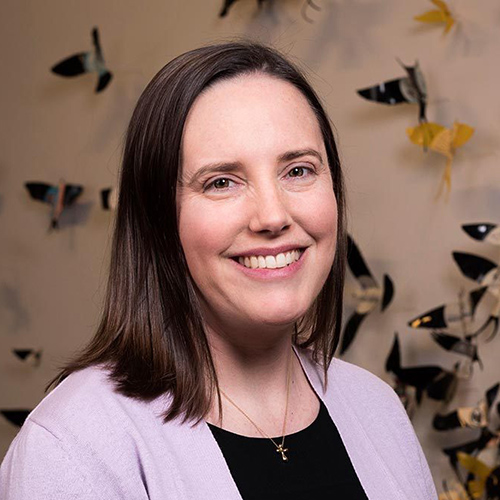“Did you know gorillas burp when they are happy?”
My 4-year-old niece proudly offered that gem (which happens to be true) on the way home recently from school. Predictably, it led to silly and somewhat gross banter about how humans demonstrate happiness. The conversation came to a halt only when she asked me a thoughtful and difficult question:
“Aunt Kelly, what do you do when you’re happy?”
Or, to put it another way: What do I do to achieve a state of happiness, well-being or contentment even approximating the delight my niece had enjoyed in sharing that weird science fact?
The question was timely. Happiness has been on my mind in the months since my friend Allison died. At her funeral, Allison’s pastor said she had a “high theology of everyday living.” Even as the cancer treatments stopped working, even as she fearfully and sorrowfully contemplated leaving behind her soul mate and her three young children, Allison delighted in mundane moments.
Watching kids’ sports practices, baking cakes, engaging in deep conversations, dancing to favorite music, even visiting the cancer clinic — all were opportunities to notice God’s abiding presence and abundant grace.
Allison’s was a beautiful way to encounter the world, but mine is much more either/or than both/and. In the face of profound systemic injustice and white supremacy, the humanitarian crisis in Ukraine, the threat of nuclear war, nearly 1 million dead from COVID-19 in the U.S. alone, and so many other examples of oppression and suffering, I tend to wallow, depriving myself of even small joys, as though that could somehow contribute to mending my broken self or our broken world.
I needed help to shift this mindset, to live like Allison.
So I did what millions of others have done: I enrolled in the free “Science of Well-Being” class on Coursera. The course is led by Laurie Santos, a Yale University psychology professor and the host of The Happiness Lab podcast. It is based on Santos’ “Psychology and the Good Life,” the most popular undergraduate course ever offered at Yale.
After taking a baseline happiness survey, more than 3 million classmates and I have explored the kinds of things we think will make us happier — things like a good job, more money, a perfect body — only to discover that we are completely wrong about what will actually improve our state of mind.
Santos blames this “miswanting” on what she charmingly calls “annoying features of the mind.” To put it bluntly, she says, “You are clueless about what is going to make you happy.”
But we can take heart. Santos teaches strategies we can employ to overcome our biases and incorrect intuitions.
What better time of year to explore such strategies or practices than Lent? To correct our miswanting to align more with what God wants? This exercise has required me to radically alter my typical approach to the current penitential season.
Like many, I have historically given up stuff like dessert, snacks, alcohol or social media for Lent. For some, such fasts may reorient their hungers toward God. But for me — and for others, I suspect — these efforts often have been a way to lose 10 pounds, make a minimal effort or appear somewhat pious.
They have not drawn me into deeper relationship with Christ. They have not led to a lasting reordering of my desires (I can’t be the only parent to gorge on chocolate while filling plastic eggs for an Easter egg hunt). And even worse, they have only deepened my focus on individualistic faith and personal improvement without the God-given and baptism-empowered vocation to pursue justice and peace for all of God’s people.
Enough of that, then.
This year, I set an intention to be, as Paul writes in 2 Corinthians 6:10 (a passage appointed in the Revised Common Lectionary for Ash Wednesday) “sorrowful, yet always rejoicing.” This year, I am WOOPing my Lent.
WOOP — Wish, Outcome, Obstacle, Plan — is the brainchild of Gabriele Oettingen, a professor of psychology at New York University and the University of Hamburg in Germany. It is a tool for helping you move beyond simply knowing what you ought to do to increase well-being, to actually changing your behavior.
WOOP is based on mental contrasting, an approach that encourages holding together in your mind your desires and the obstacles that might prevent you from realizing them.
It can be practiced daily, in just five minutes, beginning with some quiet time to focus and relax before moving through each of the key words in turn. The time horizon for your wish might be “in the next day” or something farther out, like in the next 30 days. You reflect on questions like the following, answering each with three to six words:
Wish: What is my dearest wish, one that is challenging but possible?
Outcome: What would be the best outcome of fulfilling that wish?
Obstacle: What inside me holds me back from fulfilling this wish?
Plan: What specific action might overcome this obstacle?
After that, you develop a simple if-then plan: if this obstacle happens, then I will do this thing. The point is to not grip the wish tightly.
“The wishes come, and [you] WOOP them, and you don’t need to think, ‘OK, I need to fulfill that wish now,’” Oettingen said in an interview with Santos. “That’s not the issue. It’s very unevaluative; it’s very ‘unperformance.’ Just take it in order to lead a more pleasant and constructive and fulfilling life.”
I can’t say yet whether WOOPing is making me happier. But it has transformed my experience of Lent. I have practiced almost every day, which has helped me see how often the obstacles I want to blame for a particular predicament are external.
It has helped me get in better touch with what I actually wish for in my life with God, and the steps I can take to bring that closer to reality.
And that, even in the midst of sorrow, has planted seeds of joy.
What better time of year to explore such strategies or practices than Lent? To correct our miswanting to align more with what God wants? This exercise has required me to radically alter my typical approach to the current penitential season.













